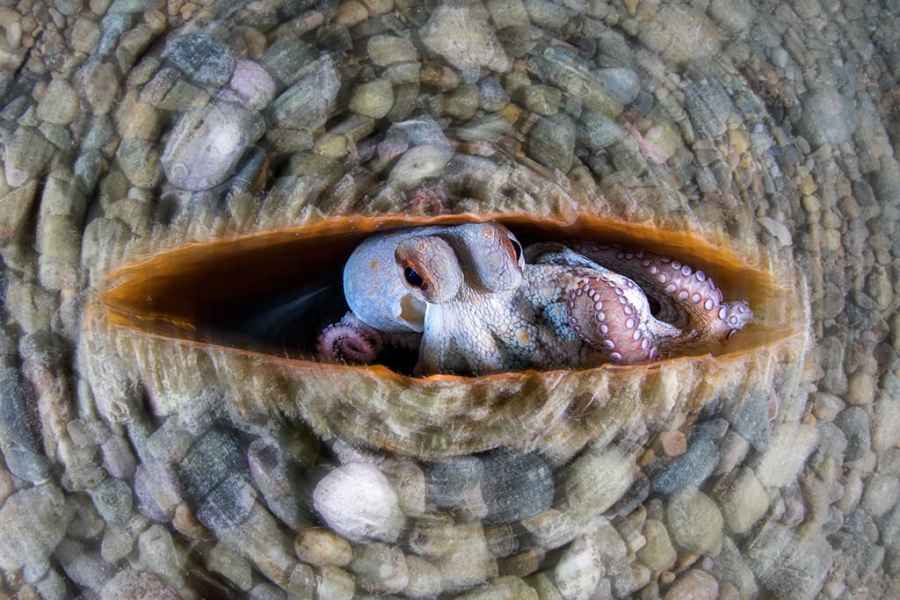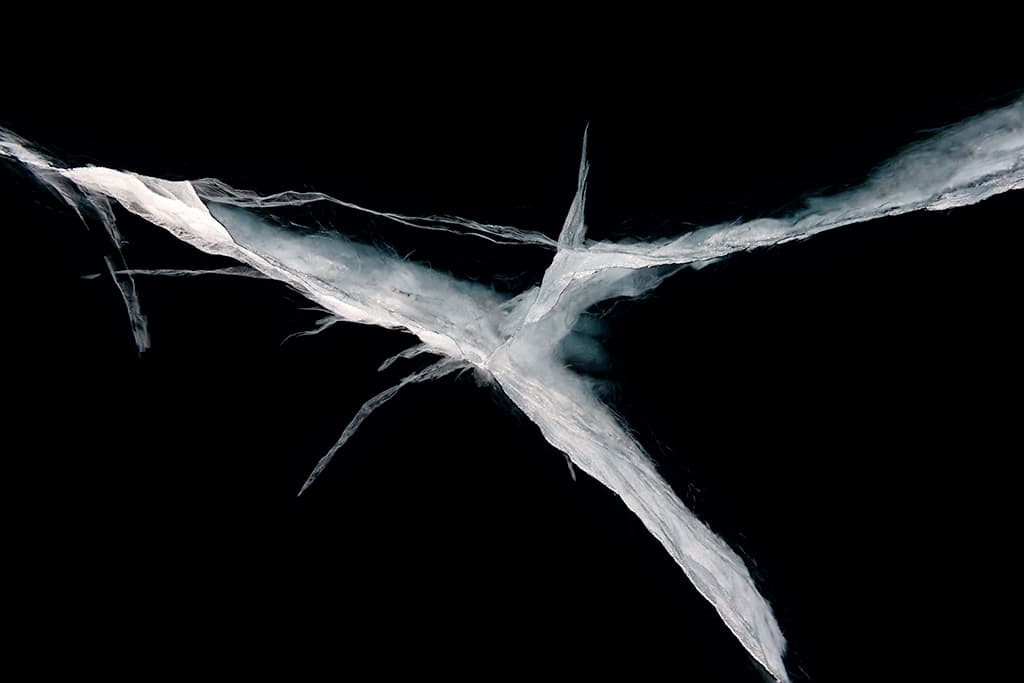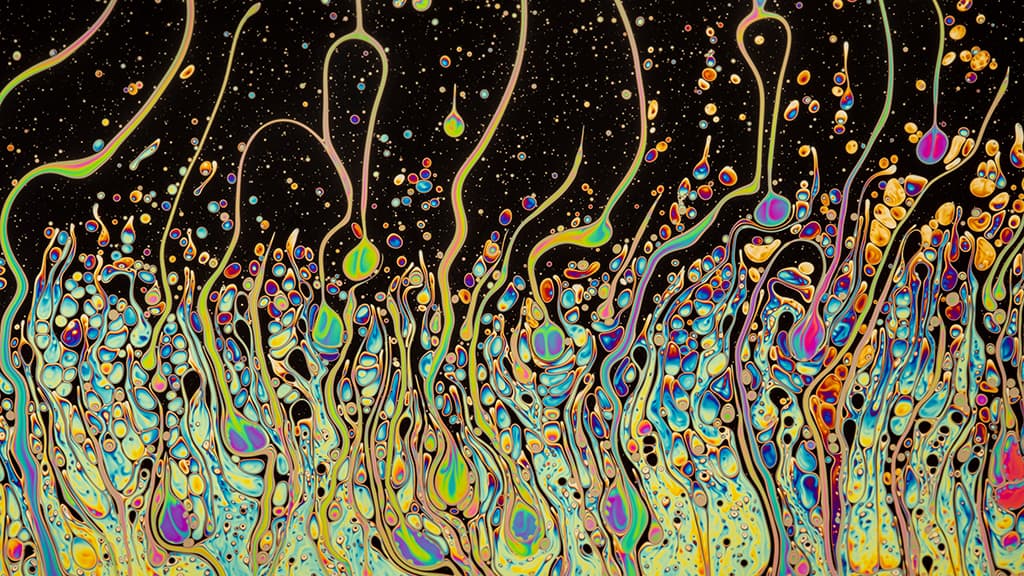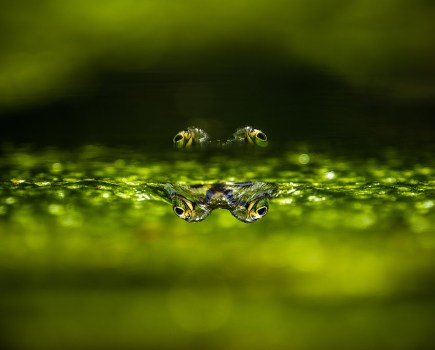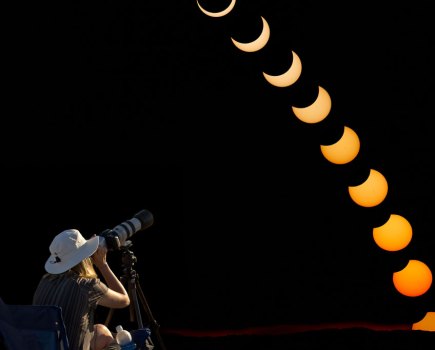Entrants to Close-up Photographer of the Year 03, supported by Affinity Photo, share the stories and techniques behind their pictures with competition co-founder Tracy Calder.
Having spent weeks looking at all of the entries to Close-up Photographer of the Year 03, the same two quotes by author and artist Austin Kleon keep running through my head. The first, ‘The ordinary + extra attention = the extraordinary,’ seems to encapsulate one of the great joys of close-up photography.
When you slow down and approach a subject with an air of curiosity then even the most mundane object or scene becomes captivating. This year I’ve been astonished by images of spiders in their rainbow-coloured webs, bottles transformed into seascapes and slime moulds erupting out of dead vegetation.
Of course, there have also been images of subjects or aspects of behaviour that I’ve never seen before: ants working together to hunt a hornet, an octopus seeking shelter in a noble pen shell, mudskippers fighting over territory, to name a few. This brings me to the second quote from Kleon, ‘Step one: wonder at something. Step two: invite others to wonder with you’.
There’s enormous joy in discovering something new, and equal pleasure in finding something that makes you want to learn more, but this pleasure seems amplified when you share it with others.
Close-up Photographer of the Year 03 received more than 9,000 entries, shot on cameras, phones and microscopes, making the judges’ task particularly challenging. There were also two new categories: Butterflies & Dragonflies, and Underwater, to add to the seven regular ones: Animals, Insects, Plants & Fungi, Intimate Landscape, Manmade, Micro, and Young CUPOTY (for entrants aged under 18).
To be a close-up photographer you need patience, persistence and a fair amount of technical skill. Above all, you need curiosity – ask yourself why a spider is weaving a web in a certain way, what might happen if you take a picture through glass/water/grass, or why a flower turns away from its neighbour, for example. Once you have satisfied your curiosity, consider sharing what you discover with others – it’s a beautiful gift.
To see the winners and Top 100 pictures from Close-up Photographer of the Year 03 visit www.cupoty.com. The next CUPOTY Challenge, which runs alongside the main competition, will open later this month. To stay up to date with all things CUPOTY just sign up to the newsletter online.


Overall Winner: Close-up Photographer of the Year 03
Pål Hermansen, Insect Diversity

Pål Hermansen, Insect Diversity. Hasselblad H3D 39, Hasselblad 120mm f/4 Macro, 8 secs at f/25, ISO 50
‘In the autumn of 2020, I discovered that one of the lamps on the side of my house in Norway had a defect and had acted as a light trap for insects. I emptied the lamp and spread the contents onto a large light-table I had left over from my days shooting slides. I used a weak flashlight to light the details from above.
I wanted to express the chaos and diversity of this discovery, but also to find some kind of composition. To me, it’s a visual reminder of the important and extreme diversity of animals around us that we take for granted.’
Top tips
1. Be open to the unexpected and receptive to picture ideas that are outside of your normal style.
2. When you’re arranging a flat lay, think about how one element relates to another.
3. There’s beauty in decay, but never kill or harm an insect for the sake of a photograph.
Winner: Animals
Juan J González Ahumada, Dancing in the Dark
www.jjgahumada.com, Instagram: jjgahumada

Juan J González Ahumada, Dancing in the Dark. Canon EOS 6D, Canon 100mm f/2.8 Macro, 20 secs at f/6.3, ISO 160
‘This opilione (harvestman or daddy long legs) was moving along a dry branch in a small hollow created by a landslip on the hillside of Sierra Blanca, Andalusia. These creatures are blind and use their front legs to guide themselves in the dark. With little space to move, I managed to light the subject from behind and used a 20-second exposure to capture the movement of its long legs.’
Top tips
1. Understand the biology of the species so that you can convey this knowledge via your picture.
2. Think carefully about how you want to light the subject to tell the story you have in mind.
3. Keep looking in interesting places and it’s amazing what you’ll find.
Finalist: Animals
Daniel Trim, Mudskipper Madness
www.danieltrimphotography.co.uk, Instagram: danieltrimphotography, Facebook: danieltrimphotography, Twitter: DanielTrimPhoto
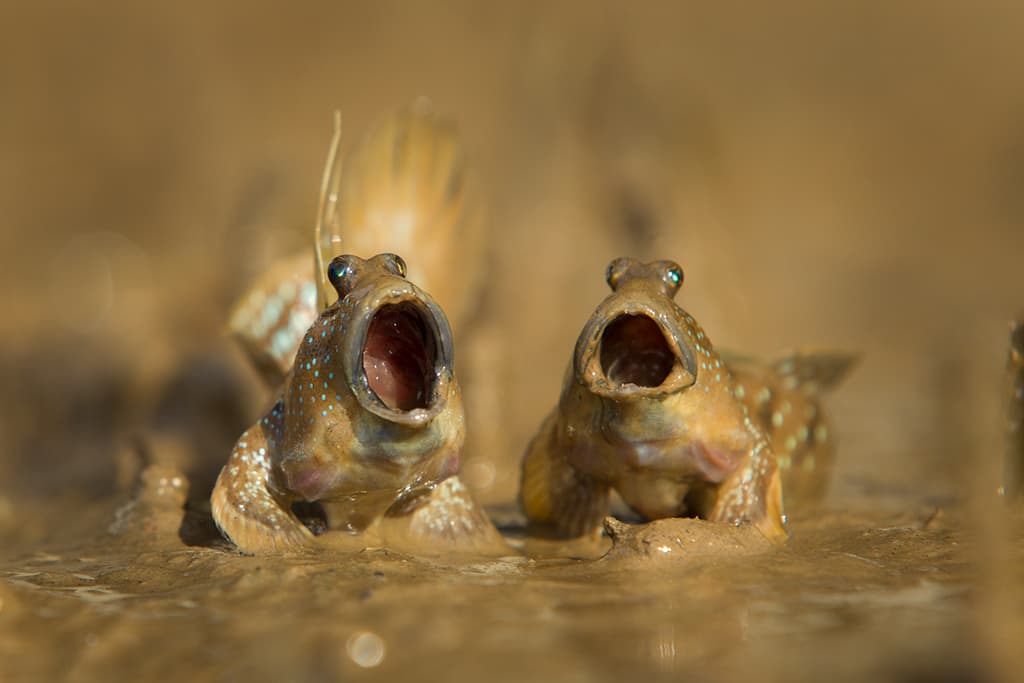
Daniel Trim, Mudskipper Madness. Canon EOS-1D Mark IV, Canon 70-200mm L IS USM f/2.8, 1/500sec at f/8, ISO 500
‘On the tidal mudflats of Krabi in Thailand blue-spotted mudskippers play out their lives unnoticed by most. The behaviour and drama become apparent when you lay down in their muddy world and see things on their level. I’d return home to my hostel every morning looking like a mud monster.
In fact, I was spending so much time laying in the mud that a local fisherman mistook me for a corpse washed up with the tide! Here, two males are disputing an area of the mudflat. It was rare to see such behaviour within reach of my camera, but I visited on multiple days in the hope that I would get lucky.’
Top tips
1. Always try to make sure that you get out there for first light.
2. Try to go that extra mile, and don’t be afraid to get muddy.
3. Visit the same location or subject many times to increase your knowledge and chances of capturing a great shot.
Winner: Plants & Fungi
Barry Webb, Holly Parachute
www.barrywebbimages.co.uk, Instagram: barrywebbimages

Barry Webb, Holly Parachute. Olympus OM-D E-M1 Mk II, Olympus M. Zuiko Digital ED 60mm f/2.8 Macro, 1/10sec at f/4, ISO 200
‘Last December, while cutting the hedge in my garden, I spotted what I thought were slime moulds, growing on a dead holly leaf. On closer inspection, I noticed amazing spikes coming out of the cap of these small, rare holly parachute fungi, marasmius hudsonii.
I took the leaf into my greenhouse, out of the wind, and spent some time carefully arranging moss behind to create a pleasant background. I deliberately chose a composition using the pointed edges of the holly leaf as a frame and to echo the spikes of the little fungi. This is a focus stack of 42 images combined in Zerene Stacker.’
Top tips
1. Photograph fungi from a low angle to get the best results.
2. Use natural objects such as moss, leaves and pieces of wood to create a pleasing background.
3. Be aware that tall, delicate fungi like these are susceptible to movement from the slightest breeze.
Finalist: Plants & Fungi
Esteve Garriga Surribas, Speculum
www.estevegarriga.es, Instagram: EsteveGarriga, Facebook: Esteve Garriga, Twitter: EsteveGarriga
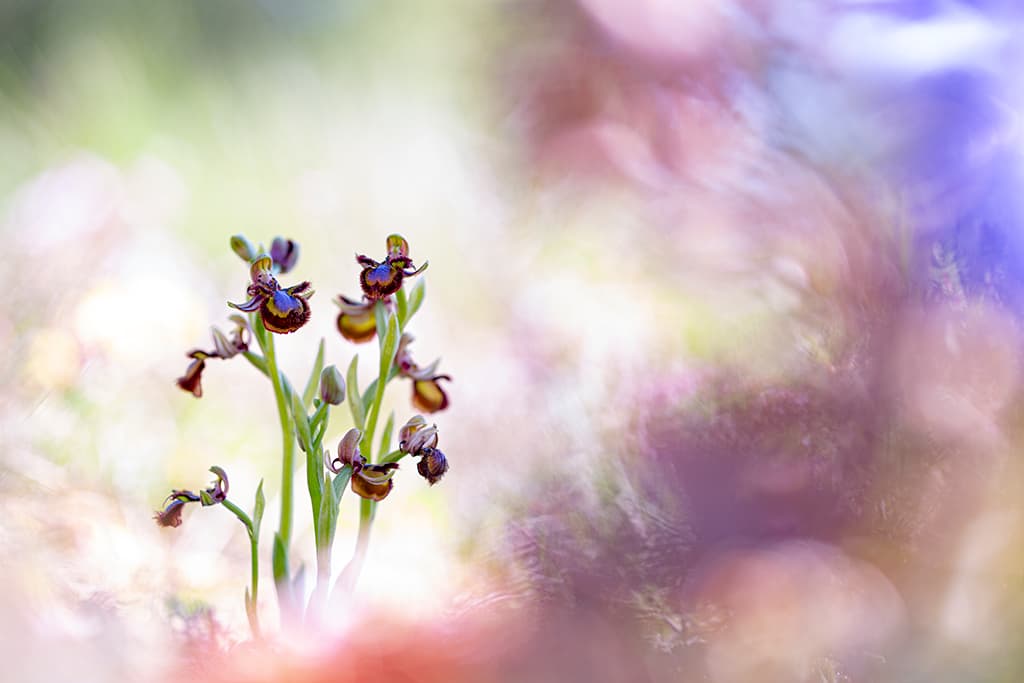
Esteve Garriga Surribas, Speculum. Canon EOS 5D Mark III, Canon 100mm f/2.8 Macro, 1/200sec at f/3.5, ISO 200
‘This group of ophrys speculum (mirror orchids) was found in one of my favourite spots near Tarragona in northeast Spain. Though widespread, it’s a fascinating plant as it’s pollinated by a single species of wasp – the males are attracted to the colour, hairiness and scent of the flower, which mimics the female. I wanted to photograph the plant in detail, against a dreamy background from the surrounding vegetation.’
Top tips
1. Spend time looking for the right specimen to photograph.
2. Look for an interesting background made up of multiple colours.
3. Work on your technique so you’re able to capture the shot in-camera.
Winner: Intimate Landscape
Daragh Muldowney, Juncture Y
www.dulraphotography.com, Instagram: dulra_photography, Facebook: Dúlra Photography, Twitter: Daraghmul
‘This picture was taken on Lake Baikal in Siberia in February 2019 as part of my recent collection, Beacons. I’ve had a fascination with ice for many years and this led me to explore the lake in detail.
I’m inspired by form and composition in nature: beautiful lines, textures or shapes that become a work of art when looked at closely or composed in a particular way. I love the intersecting lines in this small feathery crack in the ice. I processed the image in a way that would help the detail of this exquisite crack to stand out from the depths below.’
Top tips
1. Use a black umbrella to remove the sky’s reflection when shooting downwards on ice or water.
2. Wear knee-pads when you’re kneeling on solid ice for prolonged periods of time.
3. In cold places keep your batteries close to your body and keep your camera in a sealed bag when getting in and out of a warm vehicle.
Finalist: Intimate Landscape
Jane Simmonds, Nothing Gold Can Stay
www.janesimmonds.co.uk, Instagram: janesimmonds31, Facebook: jane.simmonds.96
‘The title of this image comes from the Robert Frost poem of the same name about the fleeting nature of beauty. This sentiment felt fitting for this image of beech tree branches displaying their autumnal leaves against a golden textured background.
Beech trees are the most common tree in my local woodlands in the Forest of Dean – I love to watch how the leaves change throughout the seasons: from the vivid green of spring to autumnal yellows, golds and browns. Then winter arrives and the branches are bare – sadly the gold has gone – until the cycle begins again next year.’
Top tips
1. Forget the normal rules and spend time playing and experimenting with multiple exposures.
2. You don’t need to find exotic locations – this image was made in a slightly scruffy woodland just ten minutes away from my home.
3. Try isolating individual tree branches to find interesting lines and shapes, rather than shooting an entire tree or
a group of trees.
Winner: Manmade
Rachel McNulty, Waves Crashing
Instagram: rachelmcnultyabstract
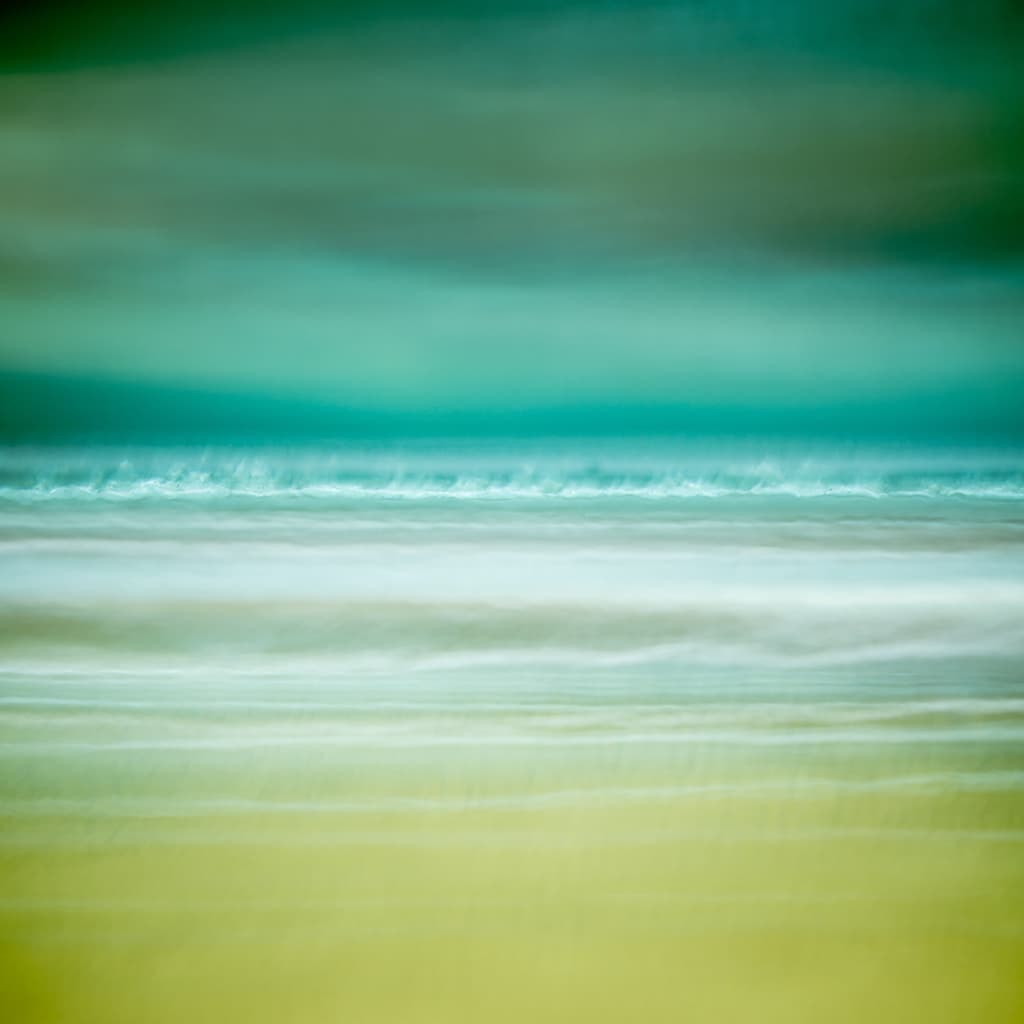
Rachel McNulty, Waves Crashing. Olympus OM-D E-M1 Mk II, Olympus M.Zuiko 60mm f/2.8 Macro, 1/8sec at f/4, ISO 200
‘At the start of lockdown last year, I embarked on a home-based project to create abstract seascapes using colourful glass bottles, a macro lens and natural daylight. This was all done at my dining room table, with the sunlight enhancing the colours and casting incredible reflections within the bottles.
When I looked through the viewfinder, I saw waves crashing on a beach, storm clouds out to sea or dramatic sunsets. No two images will ever be the same; the light changes, the position of the bottle moves, the reflections shift, just like a real seascape constantly alters.
This image was created from a close-up section of a turquoise blue gin bottle to create the stormy sky and sea. The light reflecting off the bottle appears as waves crashing on a beach and a small foil reflector was used to enhance the yellow sand.’
Top tips
1. Experiment with varying apertures and move the camera and the subject around.
2. Take inspiration from other seascape images and paintings.
3. Explore your immediate surroundings for picture potential.
2nd Place: Manmade
Bruno Militelli, Delusion
www.brunomilitelli.com, Instagram: bruno.militelli, Facebook: brunomilitelli.photography
‘A soap bubble lasts mere seconds before it bursts and returns to its original form. This image seeks not only to portray the ephemeral life of an apparently common physical phenomenon, but to also show the most diverse colours and mesmerising patterns. The psychedelic effect contained in the movement of water and soap captured against the light continually feeds my imagination.’
Top tips
1. Illuminate the bubble from behind with a flashlight.
2. Manually focus with focus peaking to ensure each exposure is as sharp as can be.
3. Keep taking pictures of bubbles because each one is different.
2nd Place: Insects
Petr Bambousek, Ants and Hornet
www.sulasula.com, Instagram: sulasulacom, Facebook: sulasulacom

Petr Bambousek, Ants and Hornet. Olympus OM-D E-M1 Mk II, Olympus 30mm/3.5 Macro, 1/100sec at f/13, ISO 200
‘Liometopum ants live in large colonies on huge trees and feed on many different types of food. In this image you can see how the group has worked together to hunt the hornet. I used a single diffused flash to light the scene and slightly cropped the image to take the viewer into the heart of the action. This interesting behaviour was discovered during a night walk in the extensive park of Lednice Castle, Czech Republic.’
Top tips
1. Try going out at night to discover new animal behaviour.
2. Walk slowly and stop regularly to give yourself a chance of finding interesting subjects.
3. Learn to use your camera properly to make shooting at night as easy as possible.
Winner: Micro
Håkan Kvarnström, Spiral Beauty
www.hakankvarnstrom.com, Instagram: micromundusphotography, Facebook: micromundusphotography
‘Spirogyra has one of the most fascinating chloroplast shapes of all algae – a helical shape, or spiral. Spirogyras thrive in almost any freshwater environment and are a common species that’s easy to find in shallow ponds, ditches and lakes.
For this picture I stained some of the spirogyra strands with a number of fluorescent dyes to highlight the spiral-shaped chloroplasts. They were then mixed with natural strands and placed next to each other on a glass slide before being photographed in fluorescent light.’
Top tips
1. Experiment with different stains to explore new photographic results.
2. Rinse the algae carefully after staining to avoid fluorescent ‘light pollution’.
3. Try to ‘comb’ the algae using a sharp needle on the slide before applying a cover glass.
Winner: Butterflies & Dragonflies
Ripan Biswas, Mating Underwater
ripanbiswas.com, Instagram: ripanbiswasphotography, Facebook: ripanbiswsphotography
‘For some species of damselfly, egg laying is a challenge. They lay eggs on submerged vegetation to prevent them from being exposed to the open air. The female climbs down into the water while the male clasps the neck of the female with a special organ on the tip of his tail. Once finished, the male will pull her up above the surface of the water.
This is a tricky time for the pair as they are especially vulnerable to predators. As I positioned my camera just above the water to start taking pictures, a water strider came close to the pair in search of food. After inspecting the mating pair, he decided that they wouldn’t make a good meal. I managed to take a few shots before the water strider departed. The damselflies flew away after successfully laying their eggs.’
Top tips
1. Use a burst of fill flash to lift deep shadows.
2. Spend time observing your subject – you might be surprised by what you’ll discover.
3. Do your research – when you know how an animal is likely to behave you can plan your picture accordingly.
2nd Place: Butterflies & Dragonflies
Andrew Fusek Peters, Painted Lady in the Garden
www.andrewfusekpeters.com, Instagram: andrewfusekpeters, Facebook: Andrew Fusek Peters photography, Twitter: 2peters
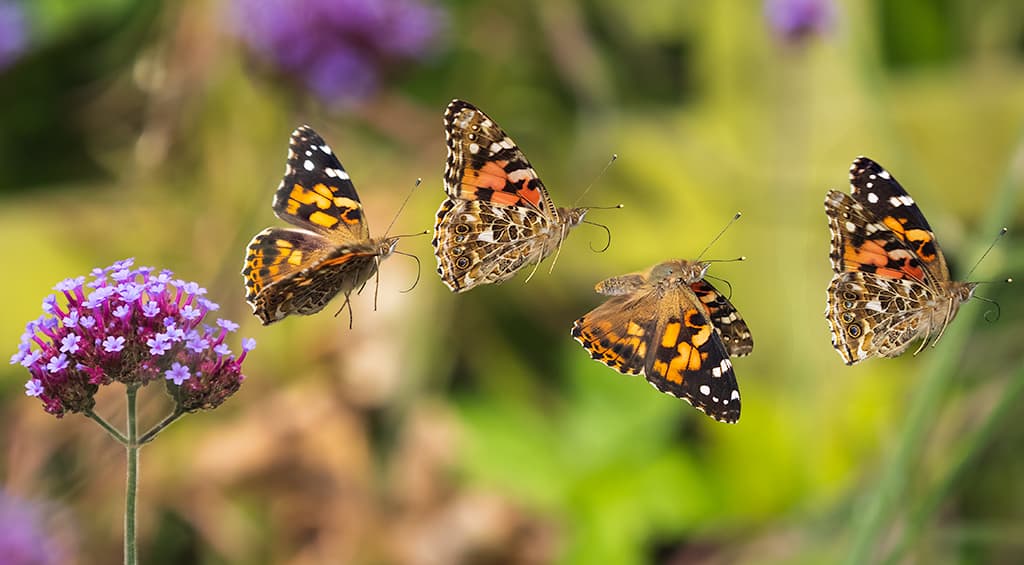
Andrew Fusek Peters, Painted Lady in the Garden. Olympus OM-D E-M1 Mk II, Olympus M.Zuiko 40-150mm f/2.8 PRO, 1/5000sec at f/2.8, ISO 500
‘I had just started shooting with the Olympus camera system and began to wonder if it might be possible to photograph butterflies in flight. This was my first decent sequence, with four good raw files from the moment the painted lady took off until it left the frame. The photos were layer masked in Photoshop to produce a composite.’
Top tips
1. Study the species you want to capture in-flight, to improve your chances of success.
2. Practise a lot. This type of work takes time and thousands of out-of-focus shots!
3. Have patience and don’t give up – when the decisive moment arrives, you will know!
Winner: Underwater
Alessandro Grasso, Circular Octopus
Instagram: alessandro.grasso73, Facebook: Alessandro Grasso Artphotography
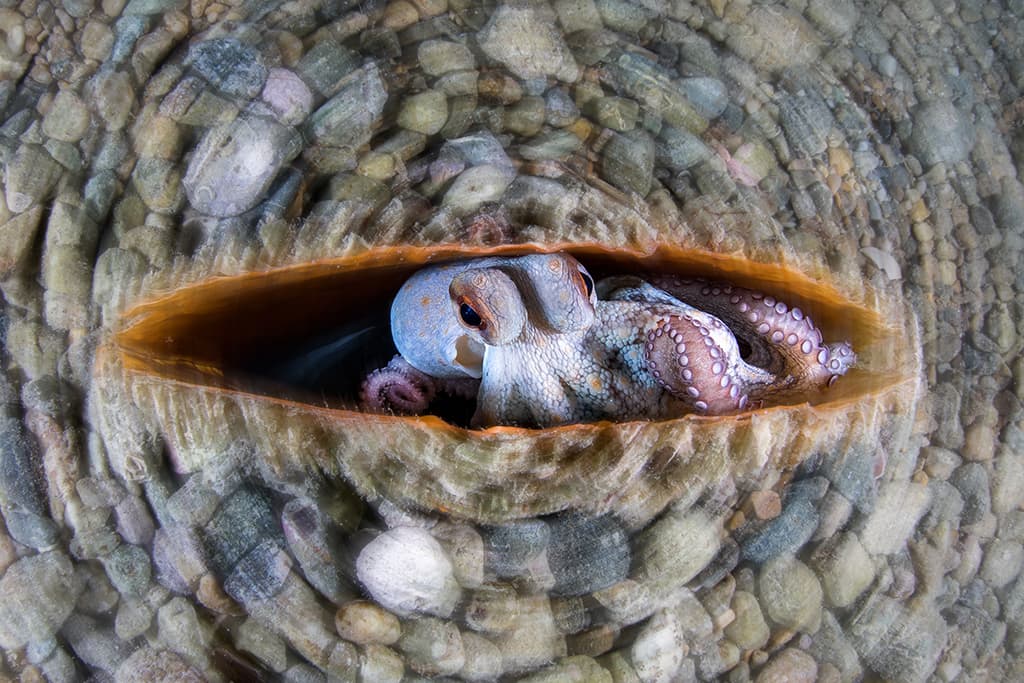
Alessandro Grasso, Circular Octopus. Canon EOS 5D Mark IV, Sigma 15mm f/2.8 EX DG Diagonal Fisheye, 1/13sec at f/22, ISO 160
‘In the past three years, the bacterium mycobacterium sherrisii has caused the mass death of pinna nobilis (noble pen shell) throughout the Mediterranean Sea. Most of the empty shells of the large bivalve have been colonised by other marine species.
In this case, an octopus has taken advantage of the large shell to create its den and protect itself from predators. I used a slow shutter speed and circular panning motion to give dynamism to the image and emphasise the subject.’
Top tips
1. Use beautiful pictures to tell important conservation stories.
2. Experiment with different techniques to expand your visual vocabulary.
3. Don’t discount other types of lenses for close-up work, such as this fisheye lens.
Winner: Young Close-up Photographer of the Year 03
Ezra Boulton, Rat in Tyre Hub
Instagram: @_ezra_boulton_
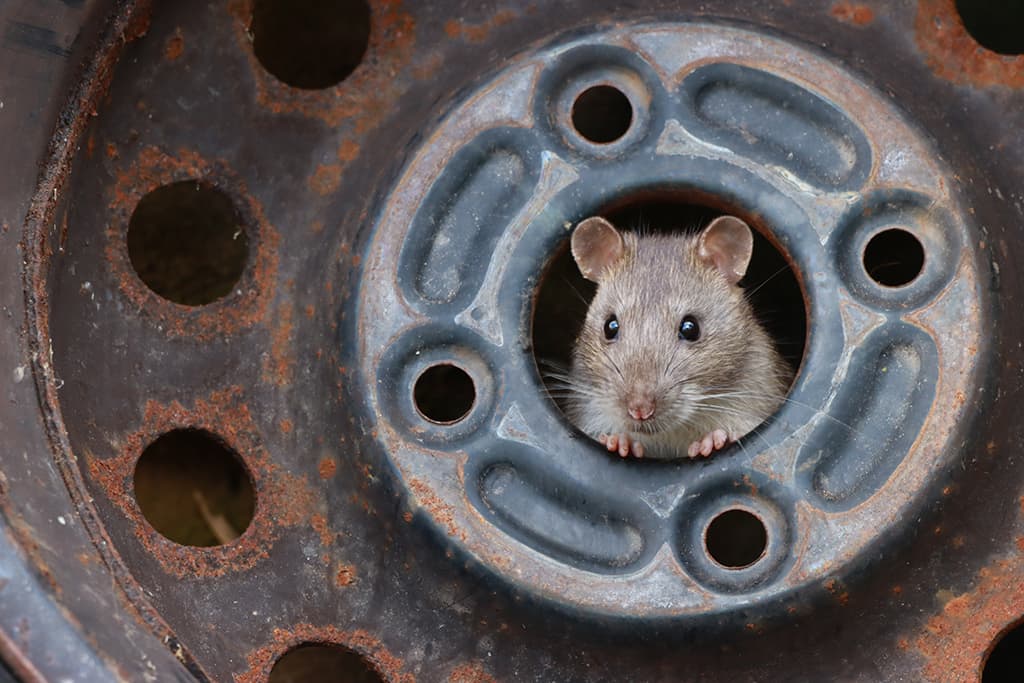
Ezra Boulton, Rat in Tyre Hub. Canon EOS 90D, Sigma 150-600mm f/5-6.3 DG OS HSM Contemporary, 1/60sec at f/7.1, ISO 500
‘I noticed this rat peering out of an abandoned car wheel in a farmyard near my home in Cornwall, England. It was framed so pleasingly by the concentric circles of the tyre that I came back the next morning with my camera hoping to capture similar behaviour. I like the way that the rat’s beady eyes echo the holes in the tyre.’
Top tips
1. Make the most of your local wildlife, no matter how common it may be.
2. Photographing an animal at eye-level increases the viewer’s engagement.
3. Wait, watch and be ready to capture the animal doing something interesting.
Further reading

